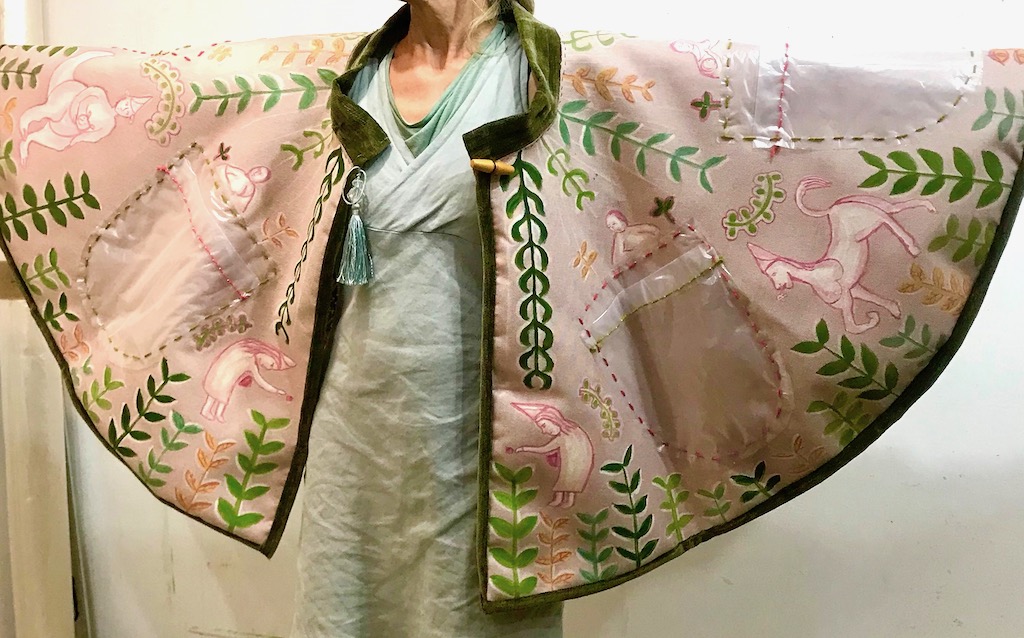
BAG THEORY PROJECT: gathering things that really matter
‘Bag Theory’ is a collection of paintings, performative objects and installations that explore eco-feminist themes of women, landscape, collectivity and care. Inspired by Ursula K le Guin’ use of Elizabeth Fisher’s ‘The carrier bag theory of human evolution’ (Women’s creation McGraw-Hill, 1975) in which Fisher proposes that the first cultural device or invention was probably a recipient and not an axe or weapon: a container, pouch, bag, sling or sack, a bag, a medicine bundle to hold gathered products, my project explores peaceful human attributes of collection and care.
The ‘carrier bag theory’ is an alternative reading of human evolution positing humans as essentially peaceful ‘gatherers not hunters’. Recognising warped presentations of history based on male ‘heroism’ and atrocity, and replacing with visual imagery that promotes the idea of humanity as essentially peaceful, not uniquely violent; representations and visualisations that might change our assumptions about inevitability of war and conflict – and instead offer hope.
Exploring the value (and values) of women who through the ages have collected, cared and worked for peace, the notion of bags and gathering reminds us of our ancient relationship to the land and nature. Garnering the role of gatherer and caretaker we can be mindful of a time before ownership of land resources (along with women, children, and animals) and promote our potential to shift into a different mode.
In past performance and installation works I have thought of bags and sacks as linking the female body to her morphology as a transformative productive container as well as a metaphor for the burdens women have to bear (eg devaluation, invisibility, childbirth, and motherhood). Embodying female productive capacity through bags has often been deeply ironic (e.g. performances ‘Bag Lady I’ 2000, ‘Handbag Readings’ 2005) and aimed to create productive dialogues about women’s bodily experiences of mothering as well as play with cultural stereotypes that define and contain women. ‘Bag theory’ retains these performative bodily resonances yet also embracing a wider context of our relationships with the natural world, en-corporating eco-feminist theory.
Painting canvas as cloth a ‘domestic’ raw material and de-territorialising it by removing the ‘frame’ breaks down hierarchical structures that make painting a hegemonic capitalist space. Using a vernacular of painted colourful patterns, figures and symbols to tell a myriad of stories about women’s lives. Performative clothing and interdisciplinary media insist on filling the void or absence of women in significant narratives. Clothing, bags and pockets announce the intention of gathering and collecting as a collective act, creating worlds where women are the the story tellers and ‘gatherers’, gathering things, stories, conversations, words, and objects to be shared.
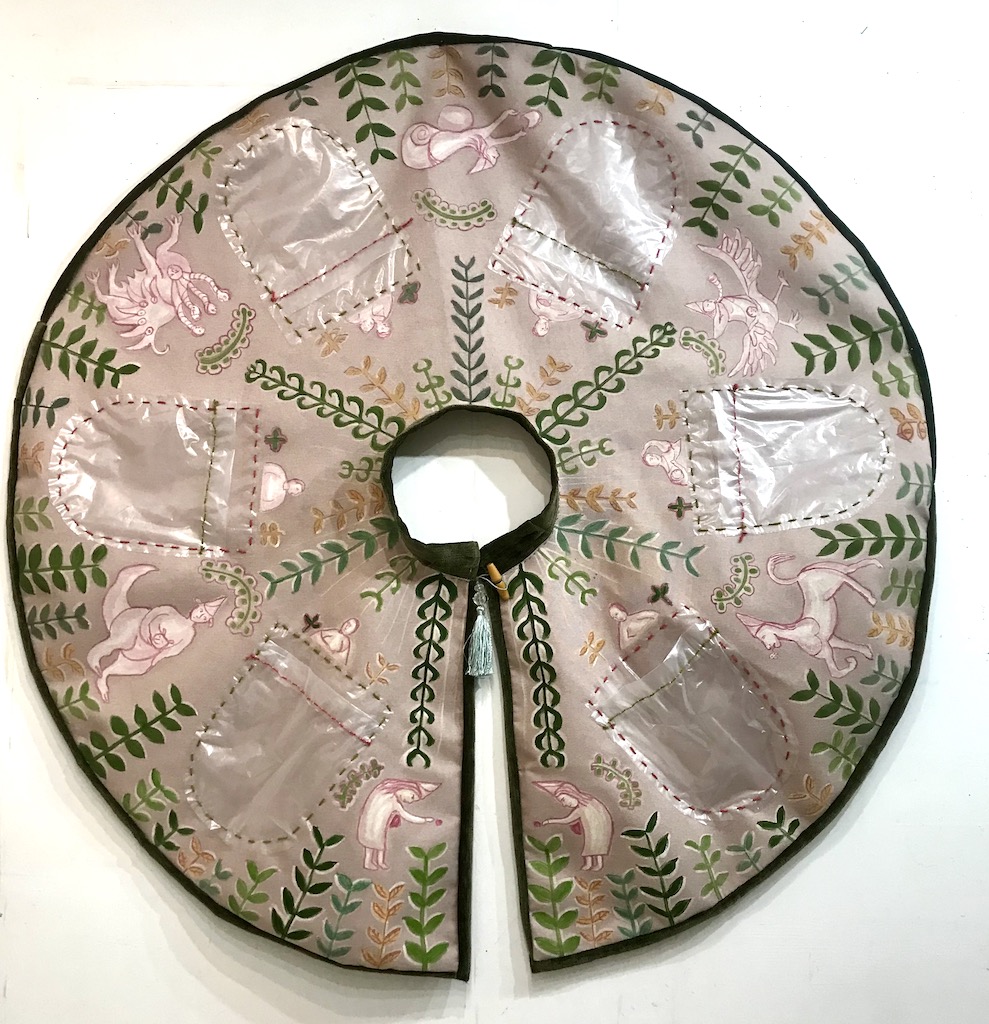
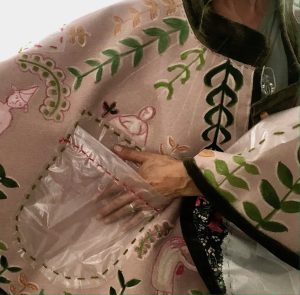

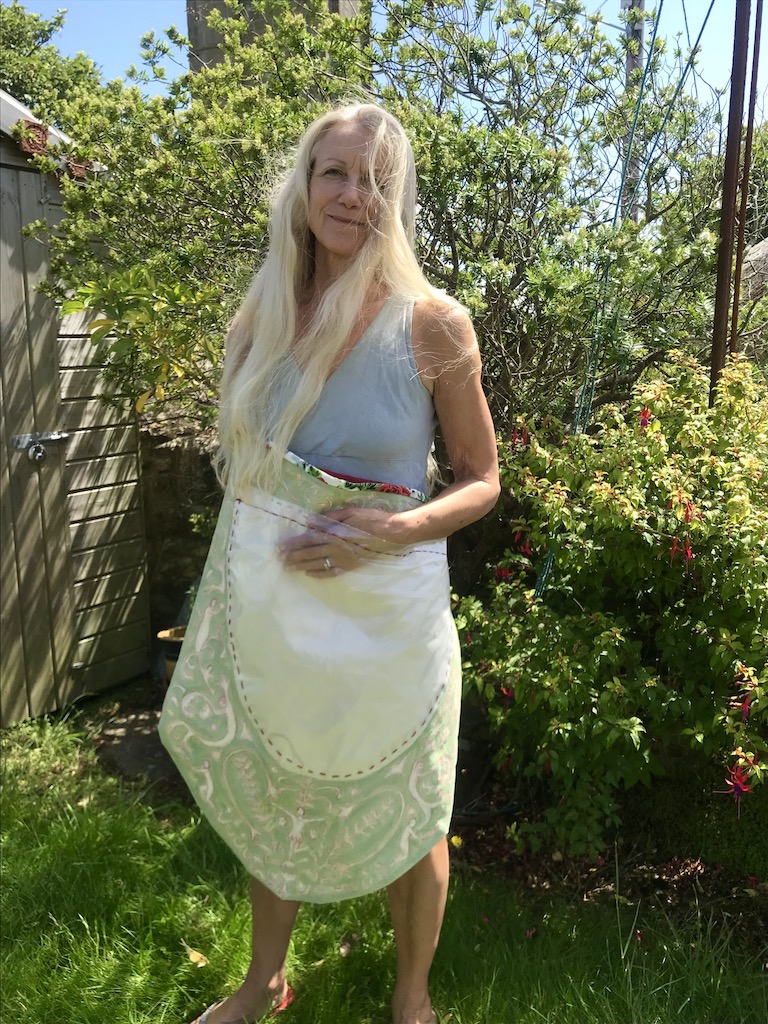
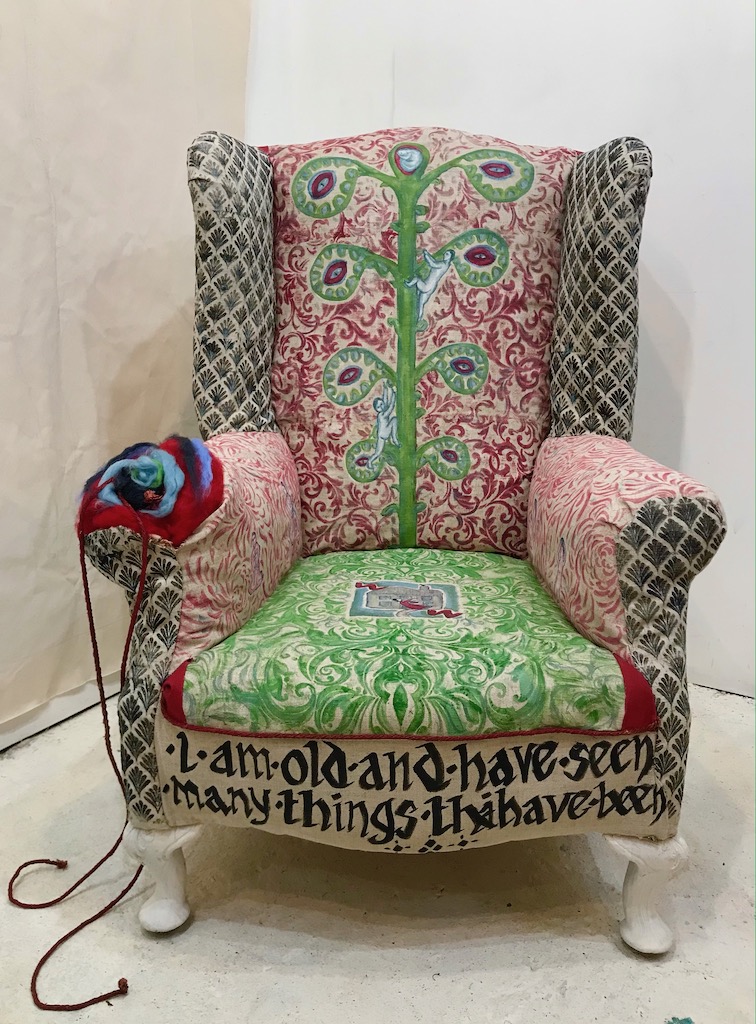
Grandma’s Story has been on show at Tremenheere Gallery (2024) Falmouth Art Gallery (2024- January 2025) & Studio Kin, Devon (May-June 2025).
‘May my story be beautiful and unwind like a long thread’
Trinh T. Minh-Ha
The title Grandma’s Story is eponymously taken from the writing of Trinh T. Minh-Ha[1] who explores the significance of matriarchal story telling and lineage, witches, wise words and healing. It includes wonderful passages from Leslie Marmon Silko, whose words,
‘set into motion the forces that lie dormant in things and beings’.[2]
Stories as organic processes and living things that are fragments of life that are not yet complete, yet their meanings never stop interacting with our lives.
Grandma’s Story is made from an abandoned chair from Penzance, Bread Street. She has been rescued and re-covered after many generations of being handed down; she is already the conjunction and culmination of many stories. There is a regal aspect to this grand old matriarchal chair and she weighs a ton (not gold but definitely iron and horsehair). Her stories and her body have been reinvented using a historical domesticated aesthetic that re-imagines her appeal for contemporary audiences.
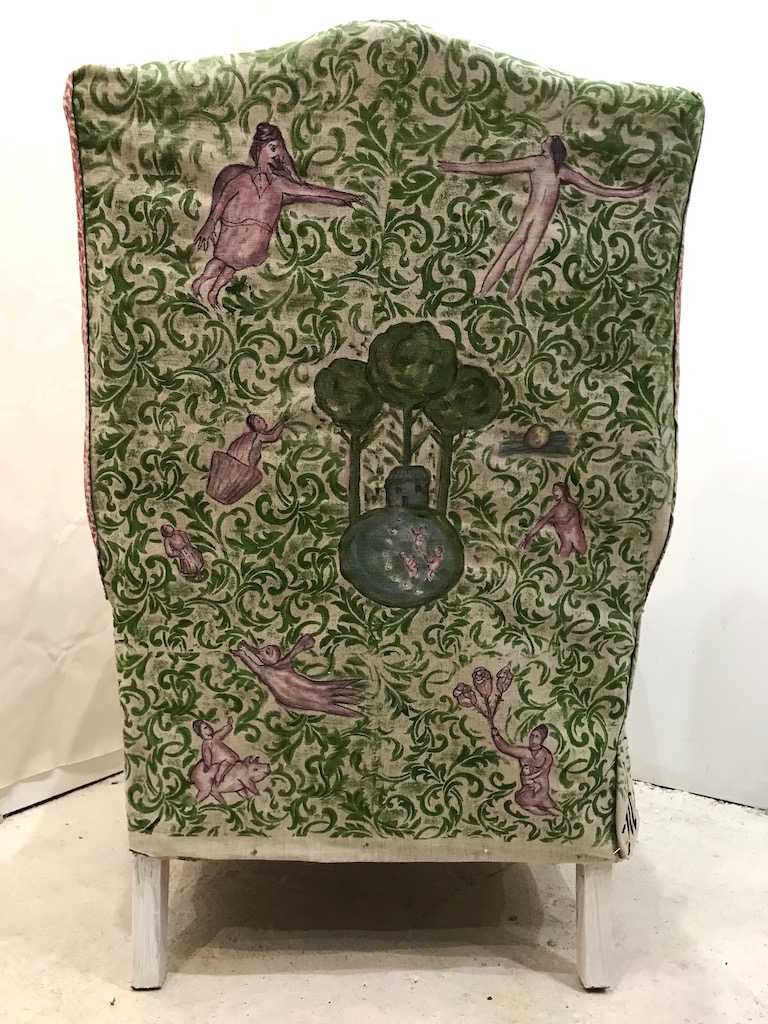
She has been re-covered with linen found in a charity shop in Penzance. Printed and painted patterns refer to stories from many sources, including a bucket load of ancient fables and fairy stories from other cultures and countries. There are hybrid monstrosities as well as endearing western tropes.
These visual stories are not sequential and cannot be read or interpreted in any particular order. A law of infinite metaphor exists in the juxtaposition of new creations and infusions of old myths. This is a kind of ‘collusion’ and a necessary ‘form of well-proven magic’. And according to Marina Warner this comes ‘offering a curse in order to command its field of meaning’.[3] Re-writing and re-imaging stereotypes of women and their lives is difficult territory. How do you re-represent women in a way that does not reinforce the same misogynist tropes about young girls and old witches that have existed since tales began? I recommend reading Angela Carter as a starting point and there are many other humorous re-tellings of traditional tales with a feminist twist by other women writers.
Whilst this fuddy-duddy old chair is decorated with visual imagery, this imagery deliberately pertains to language, whether spoken or read. She is a storytelling chair and she speaks of many stories a well as having the potential of being the Subject of many stories. You are invited to sit in the chair, read and share stories; speak, share and write your own.
Her re-upholstery is decorated with snatches of writing around the bottom trim that are taken from the hand-embroidered bed canopy that May Morris made for her father William. Words are used intentionally here, not to illustrate or explain but to make our image and word brains work together. There may even be some dissonance as the texts are no more accurate than the images; these are creative and not illustrative.
The simple and home/handmade Morris & Sons style printed pattern was chosen to bring her (the chair) to life. After all Morris’s best advice about pattern that
‘nature has to look as if its continuing to grow’ [4]
And of course there is a reference to the beanstalk story on the front of the chair.
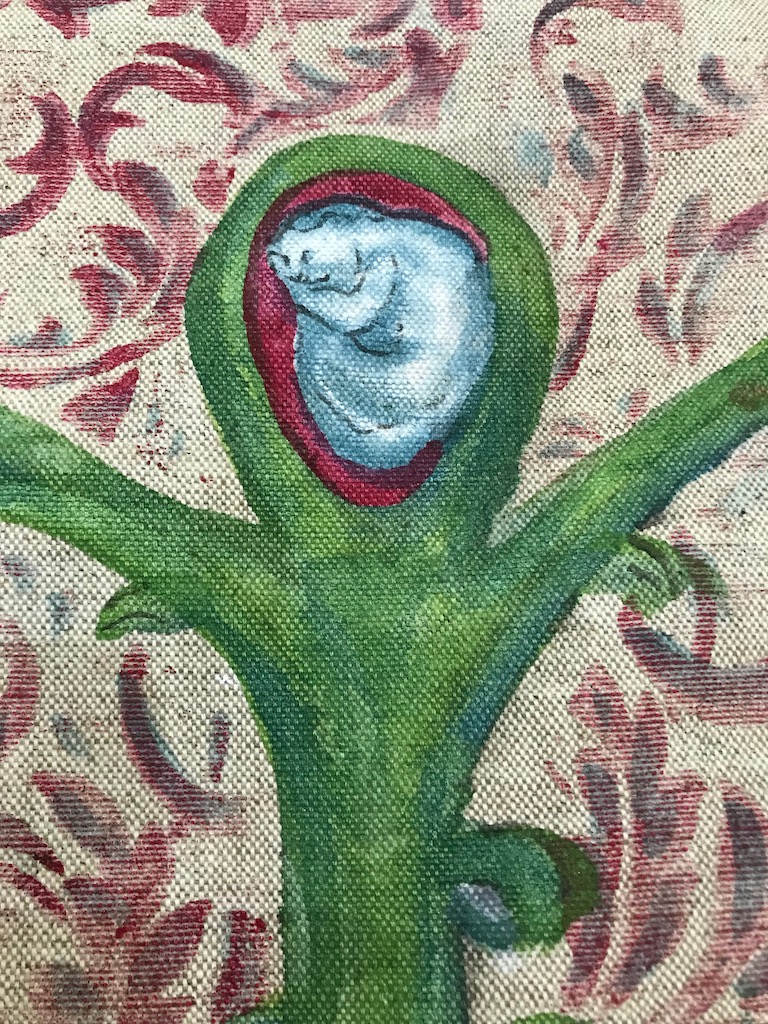
‘Allusions to ageing exposing stories and the female body, its internal organs and revealed underlying stories are places that social commentary, personal biography and fantasy may co-exist’.[5]
Hand sewing the final ‘body’ parts together on the chair was a little like creating a Frankenstein with sutures and pins. In creating her, I had in mind not only exploring old women as holders of stories but old women as a bodily conjunction between death and knowledge. Female bodies are irrational, messy and abject and she (the chair)makes allusions to the ageing female body through the colourful wool stuffing on the right arm. The stuffing was literally falling out of her, so this has been accentuated using coloured felt and wool. Exposing internal organs still carries a visceral taboo despite our enjoyment of bloody stories about evisceration or witch burning!
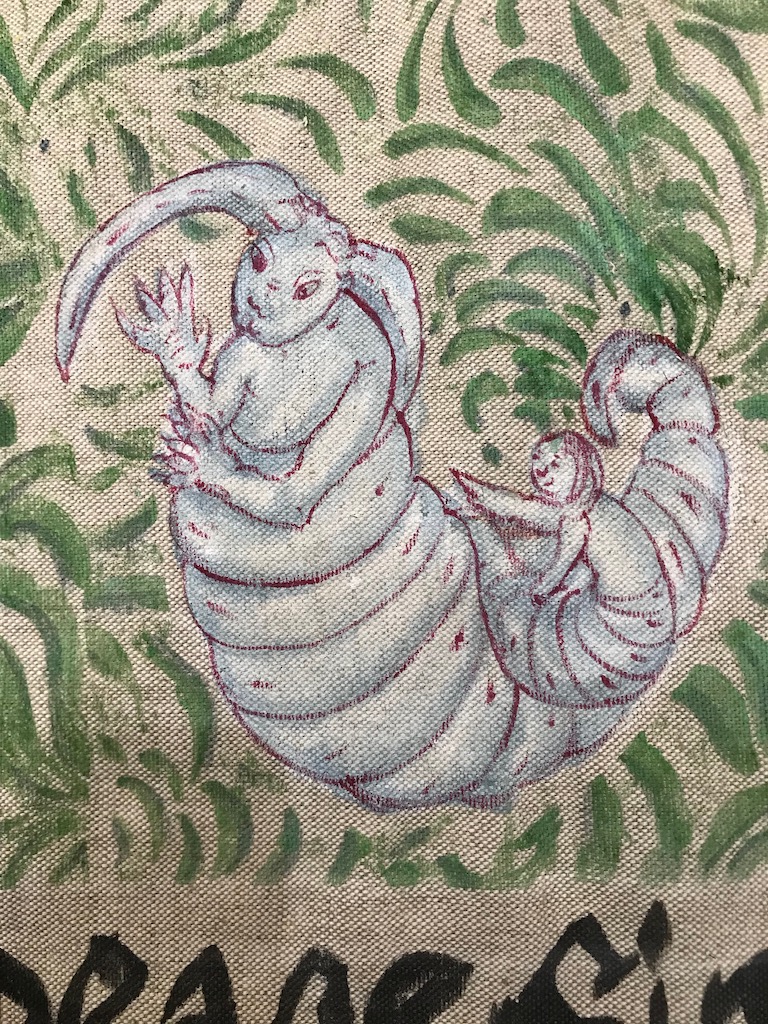
The potential of figments, untruths, and fairy tales to disclose the truth about our selves is the fruitful premise of myth. The retelling twists our fabric of reality, reveals much about how women live and how they are perceived.
So many stories are so old they have mysterious sources and adaptations existing in multifarious versions in so many different cultures yet what is common is the grandmother or baba yaga. She might help or hinder. She is an ambiguous multi-faceted figure. Totemic and matriarchal, she is beyond easy summations of good and evil. She is not simply bad or benign. She is more interesting than that. She is the story and the storyteller. She is the bearer of stories and has the the potential to transform as well as turn you into a newt if she desires.
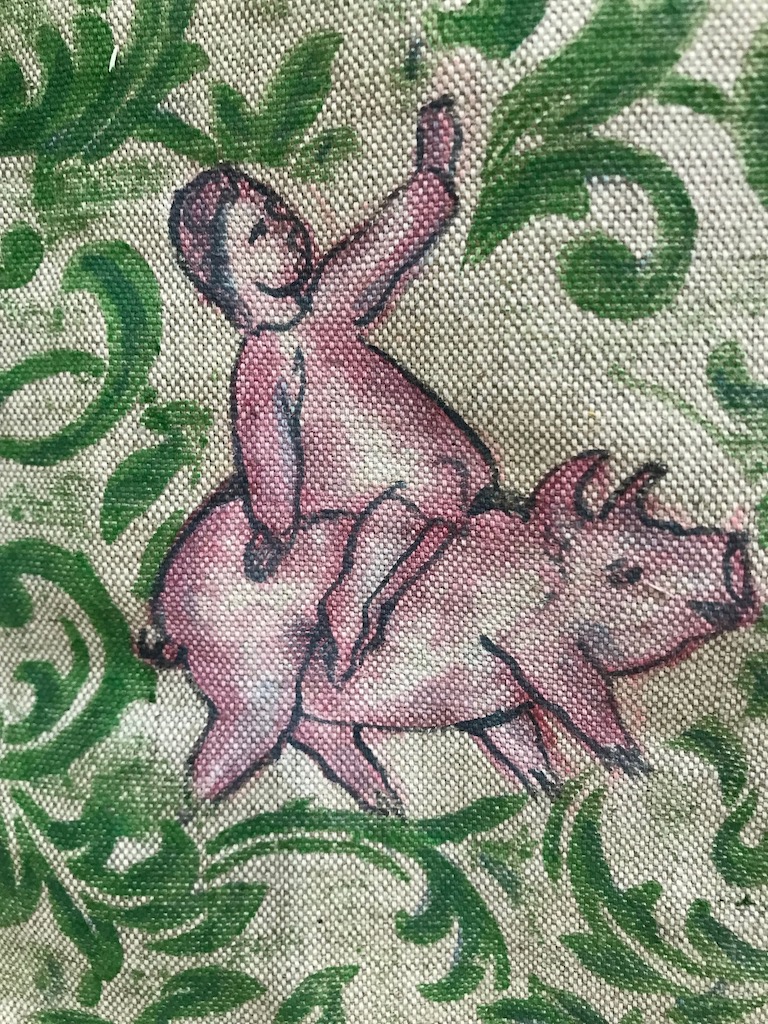
‘Storytelling, the oldest form of building historical consciousness in community, constitutes a rich oral legacy’.
Grandma’s Story is about renewing old symbolism, creating new stories, and counter-acting new invisibilities. There is something beautiful and disturbing about monsters and hybrids, contradictory characters and subjects. There is beauty and strangeness in ambiguity and there is something pleasing and grotesque about metamorphosing figures, part human, part animal. This heady mix occupies a gap or an interval ‘between what has been and becoming [something other]’. Stories are a way that we tell the truth even whilst we are making it all up.
Our imaginations know no bounds,
‘the structures of the imagination are often highly ordered and internally consistent, themselves forming understanding’ [6]
and so using stories to create understanding about women’s lived experience and lives aims to be a social commentary about value.
‘The story depends upon every one of us to come into being. It needs us all, needs our remembering, understanding, and creating what we have heard together to keep on coming into being.’[7]
Delpha Hudson, March 2024
[1] Trinh T. Minh-Ha Grandma’s Story, the final chapter of Woman, Native, Other: Writing Postcoloniality and Feminism
[2] Trinh T. Minh-Ha Grandma’s Story, the final chapter of Woman, Native, Other: Writing Postcoloniality and Feminism
[3] SIX MYTHS OF OUR TIME, Marina Warner, p.15
[4] taken from A.S. Byatt’s Peacock & Vine
[5] Anita Singh in Drawing by Andrew Malbert
[6] Myths of our time, p.20
[7] from Grandma’s story by I Trinh T. Minh-Ha in the final chapter of Woman, Native, Other: Writing Postcoloniality and Feminism
Skirting the issues performance at Soak Live Art, Plymouth, 2023
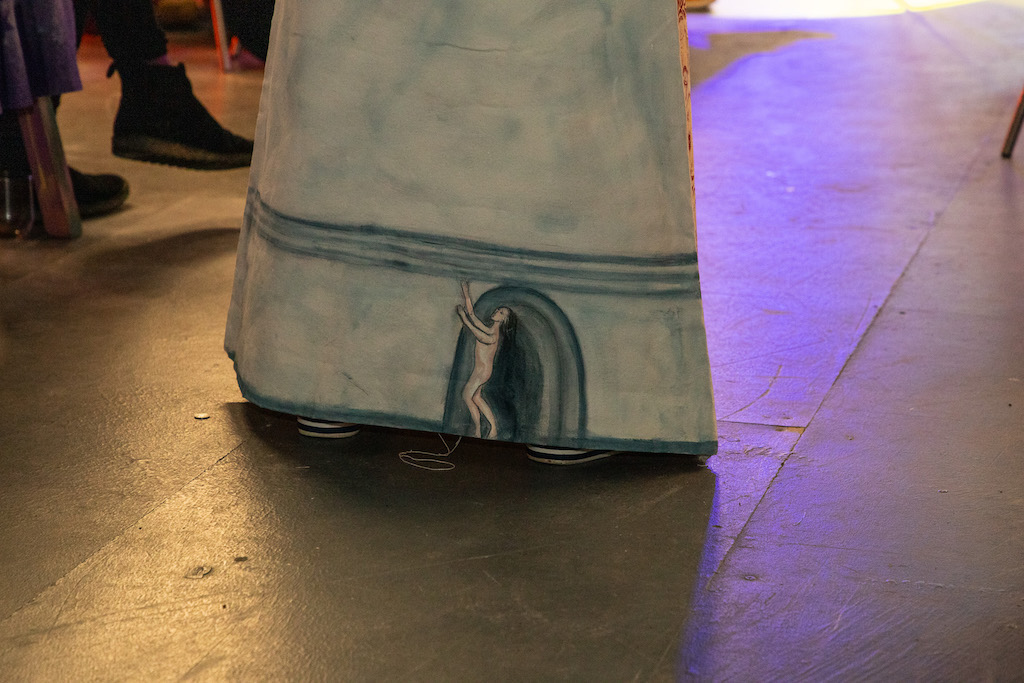
Skirting the issues, painted canvas skirt and performance, SOAK Live Art, the Leadworks, Plymouth.
Playing around with painting, personas and performance, I made a canvas skirt and neck pocket (bib) for a performance at Soak live art at the Leadworks, Plymouth in November 2023. From the painted skirt (and neck pocket (bib) I developed metaphors for maternal and domestic bodies existing fluidly between multiple subjectivities and interconnective relationships to others.
it was a wonderful supportive atmosphere to experiment with new ideas about performing and using language and objects that resonate with home and caring duties. Telling personal stories interspersed with written texts about skirting boards, equality, women and silence, I edged about the room (like a skirting board). Objects and clothing carry with them symbolic dualities of presence and absence and simultaneously propose multiple spaces between both.
The live performance had the goal of using my body as a means of re-enactment and reflection. My stories weave in and out of other’s stories of home, care and visibility. Live performances link to archive works and to new performance work and films in the landscape.
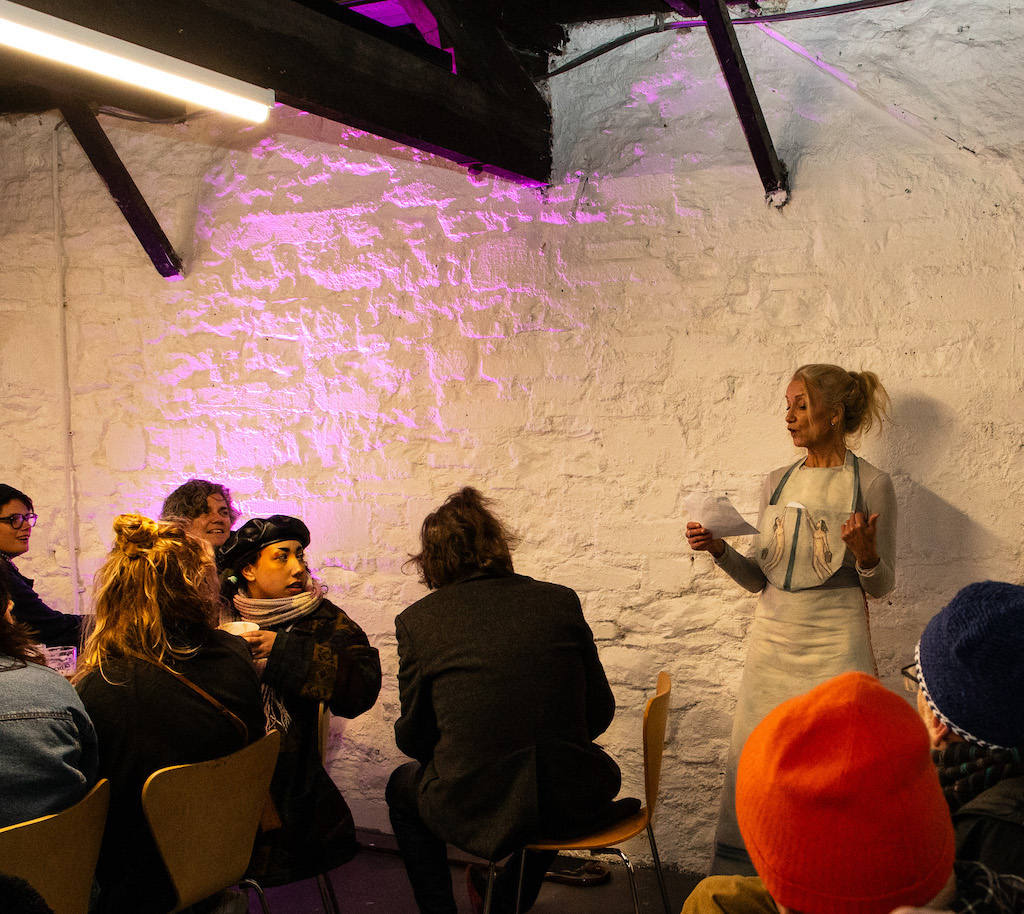
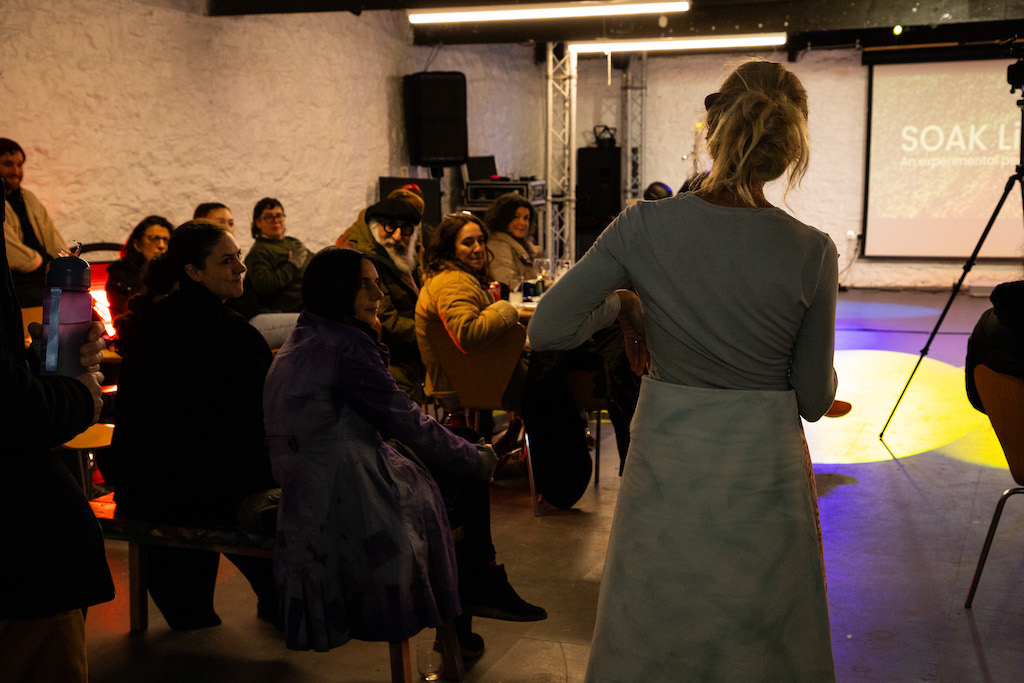
Feral Mothers, a collaboration with Helen Sargeant
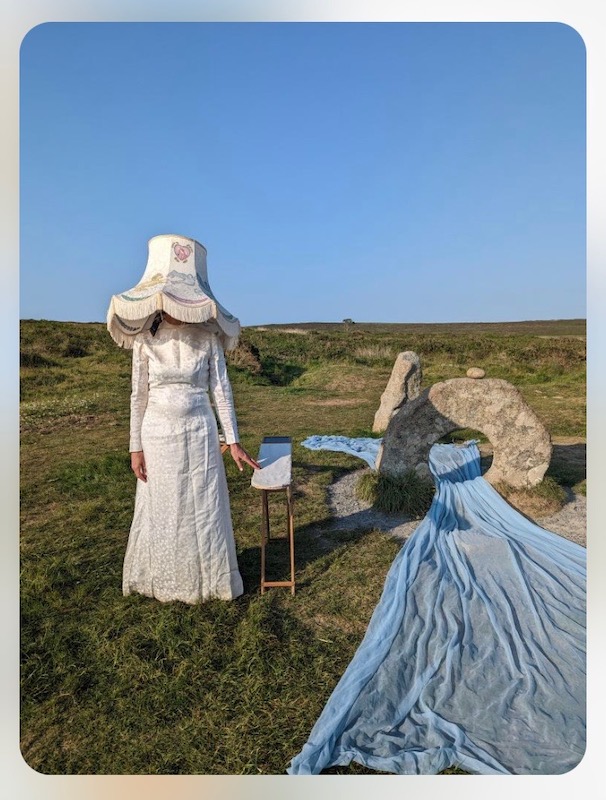
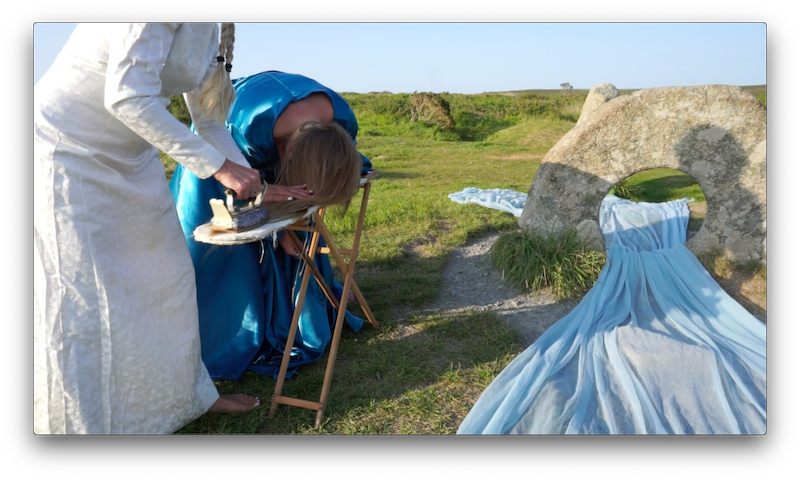
Read more about the Feral Mothers performance collaboration and find out more about films with Helen Sargeant as we explore mothering, landscape and ecologies of care.
Roses and other phantoms, Porthmeor Studios Residency, 2022
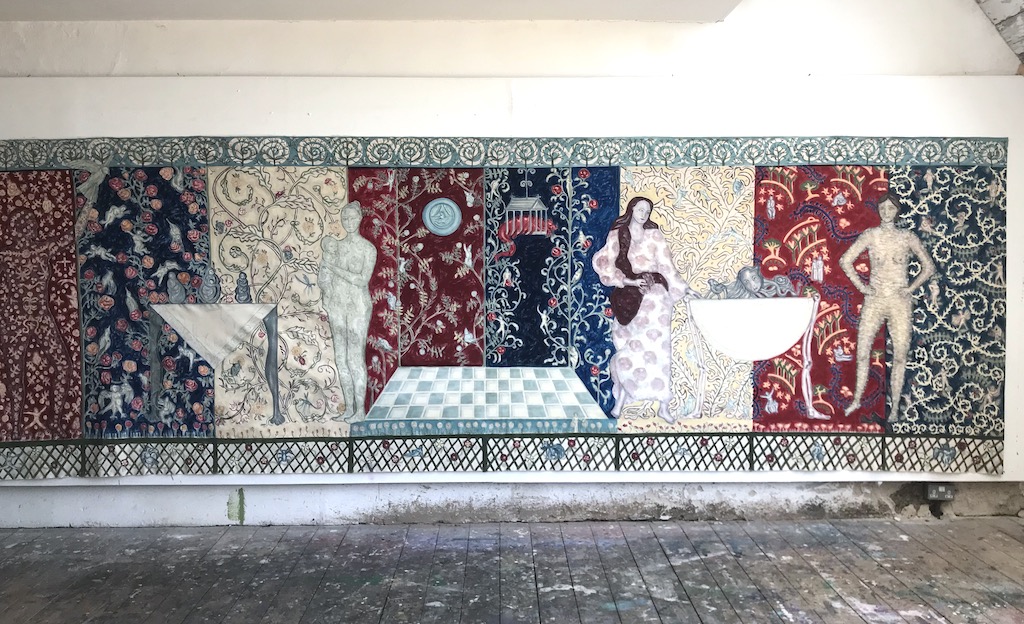
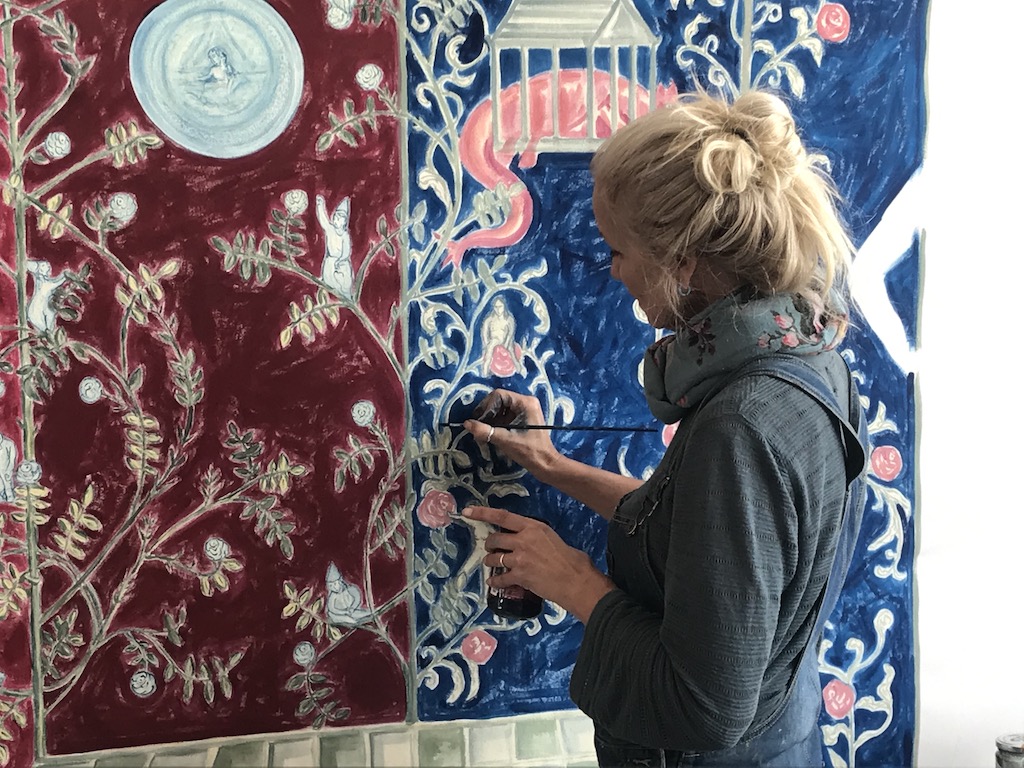
From August-October 2022 Delpha was resident at studio 9 Porthmeor Studios in St Ives to work on large scale ‘history’ paintings. The resulting Roses and other phantoms (6mx 180cm acrylic on canvas) is a tapestry-like history painting laced with socially charged inter-textual references that celebrate the mundane and often invisible lives of women.
‘For women history is not made up of one victorious moment, it is made up of daily domestic minutiae and selfless caring acts. All art explores our system of values and these paintings mix multiple frames of reference creating a dialogue between: ancient myths and contemporary tales; historical pattern and contemporary Subjects; universal symbolism and personal imagination.’ Read more…
Delpha Hudson October 2022
Your place in the world, Scottish painting commission

This commission is about as close as I get to landscape which follows the shape of the coast around Ffionphort, Mull. Medievalesque iconography seems natural for a place that faces legendary Iona. Using multiple local references, entwining fauna and flora with pattern and ancient storytelling, there are sea grasses, seaweed, Celtic sea horses, dolphins, otters, red deer, puffins, gannets, eagles, as well as kelpies, selkies, Will o’the wisps and a fairy dog (Cu Sith).
Rich traditions of folklore and legend are woven into the fabric of our lives, symbolic of the ancient necessity to tell stories. It was commissioned and made by collaboratively sharing local stories and myths. Your place in the world is about home, nature, and some of the wonderful people who care for the places they live.
Delpha Hudson, January 2023
One+All: a site-specific painting project engaging in themes of care and collectivity
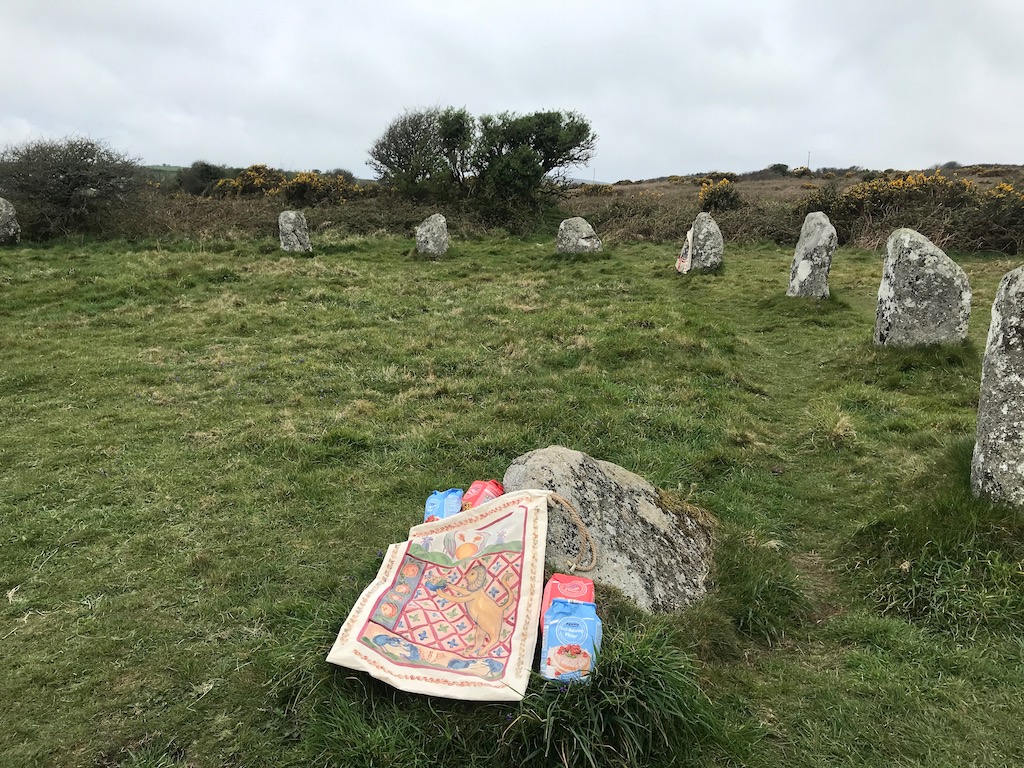
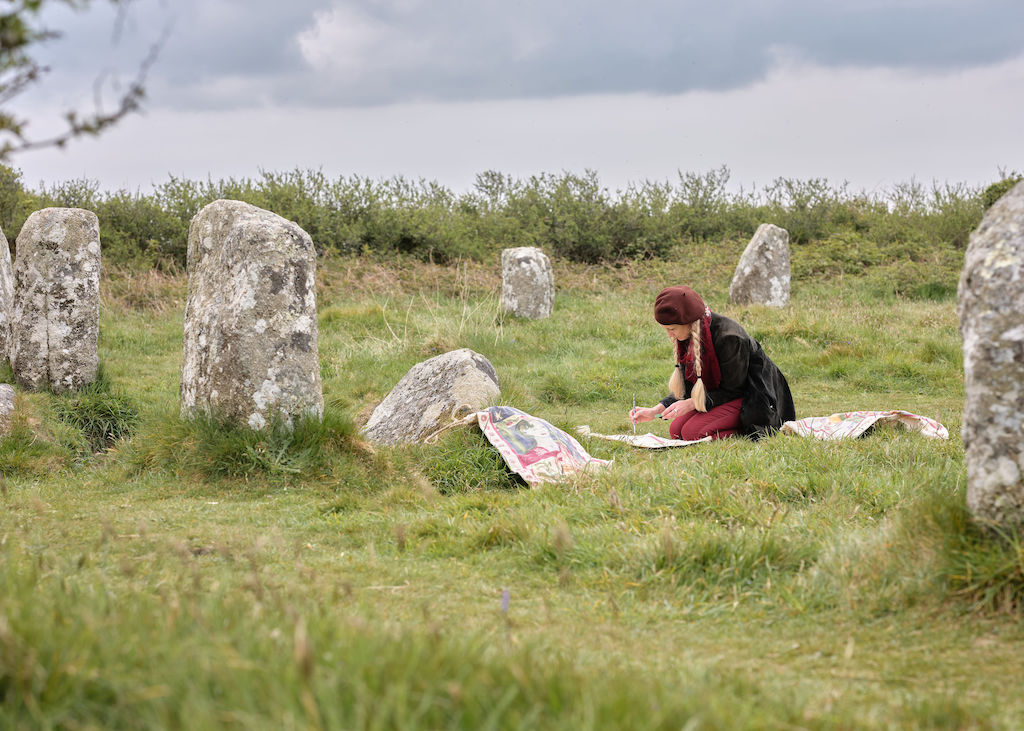
Creating Social & Conceptual Networks, th is 2022 project invited participants to engage in dialogues about local networks that support others, including food sacks that can be used to donate food to local food banks.
‘I’ve been painting in situ at Bocawen’un stone circle making personalised food sacks and gifting them to participants, who are invited to donate to local food banks. Dialogue and co-creation of a performative contemporary ritual of gift at my local circle explores sharing societal care and visibility through the metaphor of the food sacks at this ancient assembly point.
St Buryan stone circle at Bocawen’un near my home is a regular haunt. It hints of unknowable ancient human presence and networks, its sense of history and connection that is further enhanced by a ‘flint factory’ field nearby. The flint, not indigenous to Cornwall speaks of a pre-historic Cornwall as a hub with connections all over the world
Over millennia stone circles were ancient assembly points, a space that people came together – to celebrate –whatever they valued. Appropriating this ancient space and its myths for a contemporary art event that celebrates quotidian caring for others including but not confined to families and parenting. Taking the circle as a starting point, art has the potential to create new myths and cyclical reinventions of what we value’. (Delpha Hudson, April 2022)
The project was featured on the synesthesia project , Cornwall
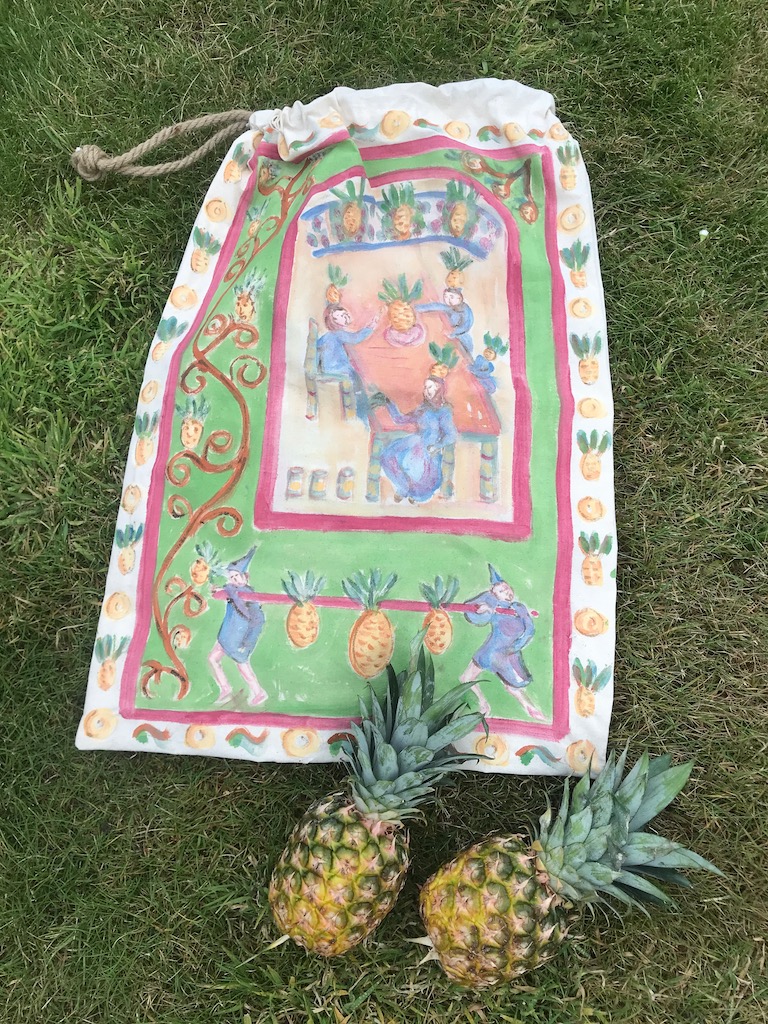
Small Promethean Acts, Derby, 2019
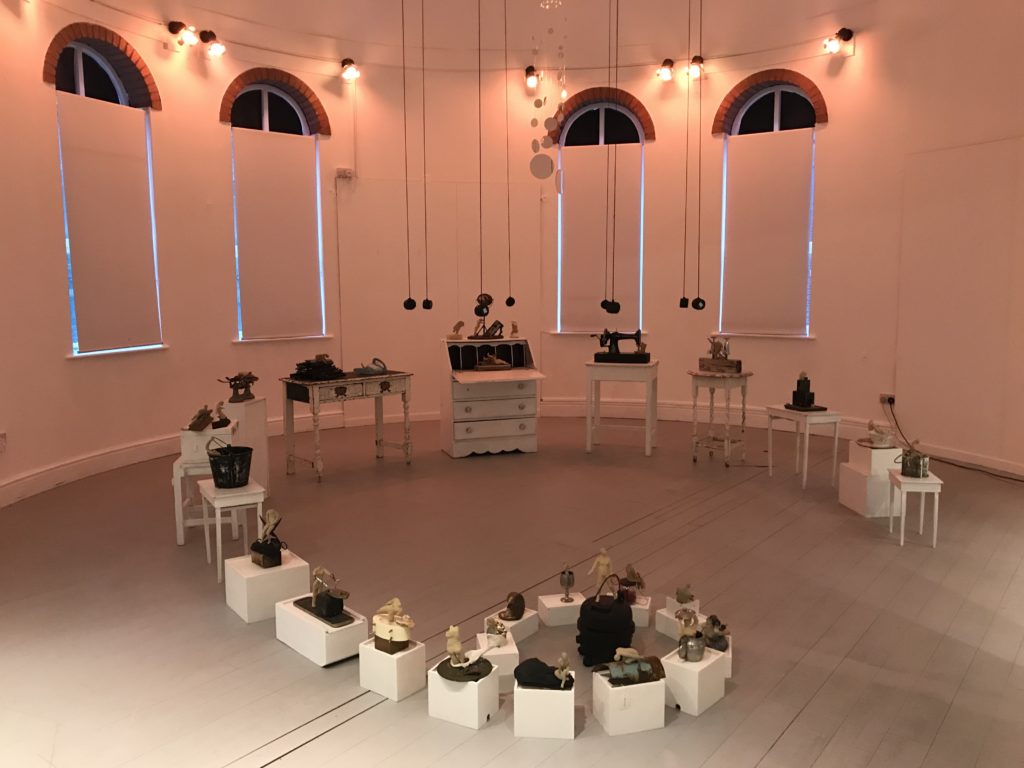
Read more about sound, sculpture and installation projects on my sculpture page.
Theatre of the Self – a project about women, diary keeping and mental health
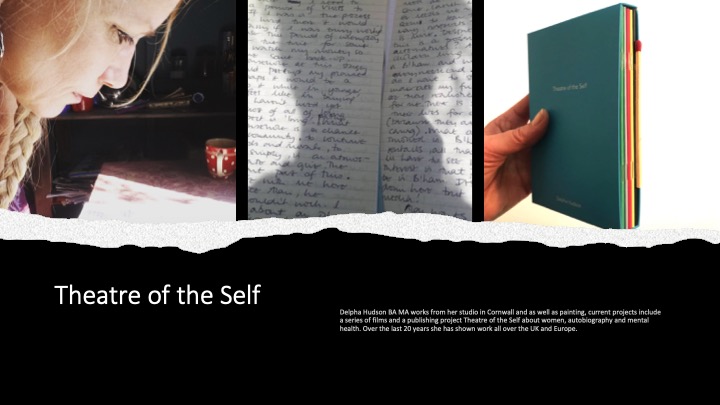
The Theatre of the Self box set of five A6 books was supported by Arts Council & Cultivator funding and a limited edition print was the culmination of a 3 years project and was published in 2021. Read more about Theatre of the Self project or watch a film
Performance, film, and sculptural installation projects on Delpha’s archive
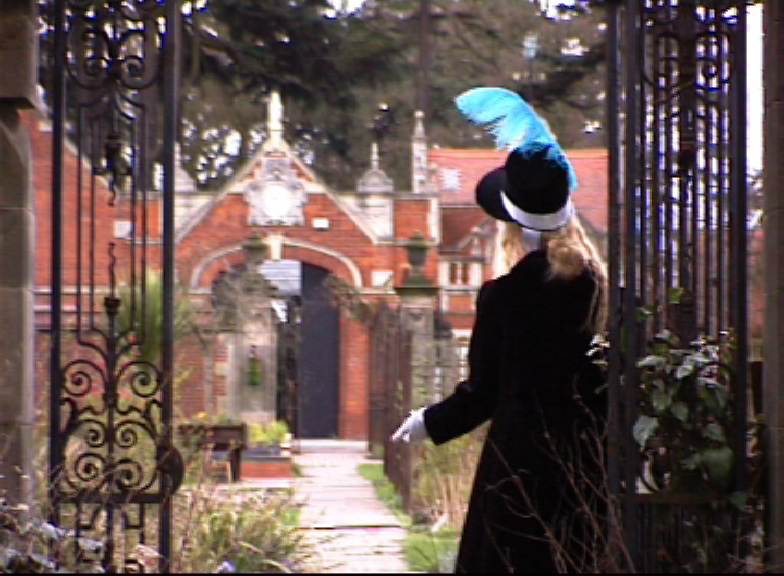
Follow these projects on @theatre of the self